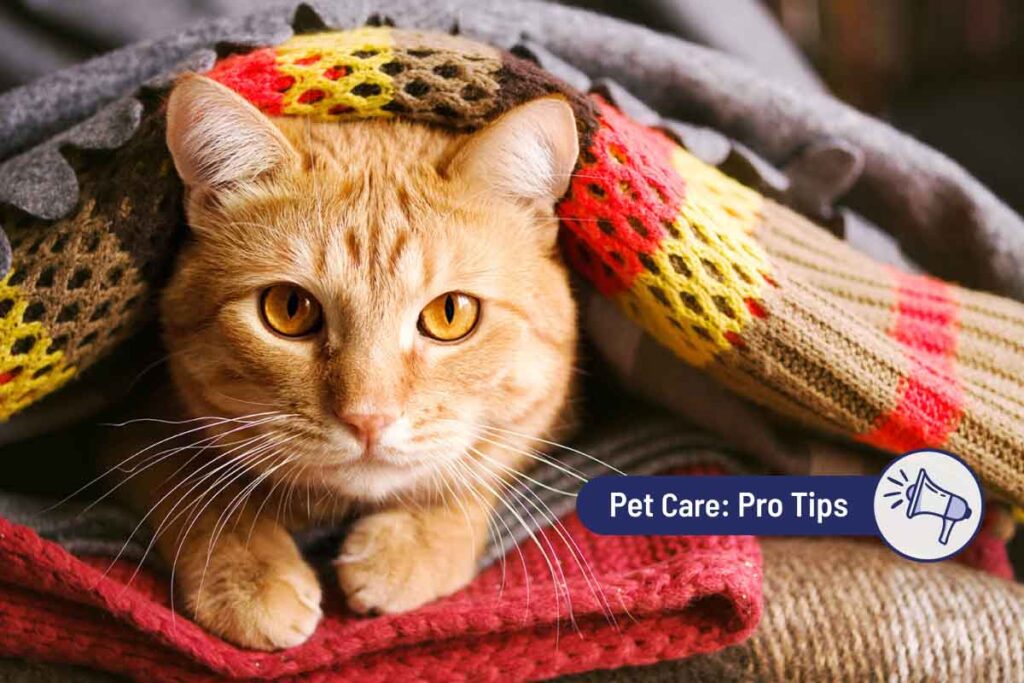Reviewed by: Dr. Robert Menardi, DVM
How do I know if my cat’s in pain? Unfortunately, our cats can’t speak up and tell us when they’re uncomfortable, but there are subtle signs that can clue you in — as long as you know what you’re looking for.
We’ll look at what might cause your cat to be in pain, what symptoms to look out for, and what you can do to help if they aren’t feeling their best. You’re your cat’s number-one ally and advocate, after all.
What Causes Pain in Cats?
Cats experience pain the same way we do — the activation of specialized pain receptors throughout their bodies. While pain is regularly perceived as bad, it serves an important purpose; pain is a protective response that warns that something is wrong.
Pain can be either acute (short-term) or chronic (long-term). Examples of acute pain are a broken bone or a urinary tract infection, while chronic pain includes health issues like arthritis.
While the pain may feel different in every situation we mentioned, it all works the same — the affected pain receptors recognize a problem and send warning signals to the central nervous system via the nerves. Think of it like the body waving a red flag, doing what it can to alert the brain that a problem needs to be addressed.
But pain is so much more than just a physical sensation. Although we can’t talk to our cats about it, pain is also an emotional experience. How do you feel when you’re in pain? Do you want to be around people, or would you rather everyone just leave you alone?
Cats likely go through the same range of emotions, leading to behavioral changes that can help us better detect when they’re in pain.
What Are Signs My Cat Is in Pain?
It can be difficult to know that your cat is in pain, particularly if they have a chronic condition or illness, because their instinct might be to hide their pain from you until their situation has progressed.
If a cat has an injury or a sudden onset of an illness or disease that is causing pain, you will probably notice certain behavioral signs. Your cat can’t rate their pain on a scale of 1 to 10, but they can show signs that something is happening that they can’t tell you about. Every cat will react to pain differently, and it is important to be aware of when something seems ‘off’ with their behavior or your interactions.
Look out for the following signs of pain, which should trigger you to schedule an appointment with your veterinarian as soon as possible.
Behavior Changes
One of the first ways your cat will show signs of pain is through behavioral changes, which is why it’s crucial to know your cat’s baseline. For example, a cat that is usually friendly and loves to spend the day curled up on your lap may start to spend more time alone or even hide from you when they are in pain. They might stop showing interest in toys or other methods of play.
Another pain-related behavioral change that can be easily overlooked is overgrooming, especially if your cat seems to be paying extra attention to one specific area. Overgrooming a leg or a spot on their back could mean pain in that region. Constantly licking at their genitals could indicate a urinary tract or anal gland issue. Conversely, a cat in pain might also stop regular grooming causing their fur to become messy and matted.
A change in vocalization can also be a hint, as there is a lot we can learn about our cats by listening to the noises they make and paying attention to when they make them. Vocalizing is one of the best forms of communication cats have to be able to talk to their pet parents.
Each type of noise they make — purring, meowing, hissing, growling, etc. — tells us something different. In particular, yowling is frequently used to express pain. Some cats may also hiss when touched or even when they groom themselves, especially if there is a painful spot.
Be careful: some cats may show increased aggression when they are in pain. Even a cat that is normally very tolerant may bite or scratch if it is stressed or trying to protect itself from a painful stimulus.
Lethargy
Changes in your cat’s energy level can also clue you into their pain status. If a cat suddenly sleeps more than usual or is reluctant to get up and move around the house, it’s likely more than just feline laziness.
Pain can be exhausting, especially if it’s severe or chronic. When the prospect of moving hurts more than just staying still, you may see significant changes in their sleep patterns.
Your cat might also display restless behaviors. If they can’t seem to get comfortable and pace around, it might be because they are in pain.
Drooling
Dental pain is a common reason your cat might begin drooling. Anything from a broken tooth to a mouth wound could lead to drooling. Gingivitis, a buildup of plaque that affects gum tissue, is common in cats. Untreated, it can lead to periodontitis, which might result in tooth loss. Abdominal pain or nausea can also be causes for drooling.
Not Using the Litter Box
There are many reasons a cat stops using the litter tray — behavioral and physical. Pain is one of those reasons, especially if it comes from the urinary, anal, or GI system.
Our cats don’t have the same ability to use logic that we do, so they’ll often put things together that aren’t necessarily related. If it hurts when they use the litter box, they may think that relieving themselves outside of it will hurt less. They can also have difficulty getting into the litter box or even struggle to squat properly to relieve themselves, particularly if they have lower back or hip pain.
Paying attention to what type of accident they’re having can tell you a lot. If your cat regularly pees outside the litter box, this may point you toward a urinary tract infection.
If it seems to be only bowel movements, you may be looking at an anal gland issue or an upset stomach. The consistency of their stool is also key — is it loose? Watery? Dry? Make sure you grab a sample to take to your veterinarian!
Postural Clues
Your cat’s posture can also clue you into their discomfort. Cats experiencing pain often stand in unusual positions, like arching their backs or tucking in their abdomens. If they can lie down, many cats dealing with pain will tuck their legs underneath them.
Their posture can also tell you if a specific area is causing an issue — not limping or not putting any weight on their right hind leg when they walk or squinting their left eye, for example.
In addition to body language, you should also pay attention to your cat’s facial “posture.” Facial expressions that a cat in pain may show include grimacing, staring blankly, or furrowing their brow. They may also have enlarged pupils, flatten their ears against their head, or flinch away from you when you try to pet them. Researchers at the University of Montreal established a Feline Grimace Scale to help veterinarians determine a cat’s level of pain from their ear position, orbital tightening (squinting), muzzle tension, whisker position, and head position.
Loss of Appetite
Pain can also cause your cat to lose their appetite, especially if the source of their pain is dental or GI in nature.
Think about it this way — if you were dealing with dental disease and your teeth or gums hurt, would you be motivated to eat? Likely not, especially if the food that’s available to you is hard and crunchy. The same thing goes for GI problems. The decreased appetite isn’t because your cat is being picky; it’s likely because their stomach hurts too much to make eating pleasurable.
If your cat doesn’t eat, they’re not just at risk for weight loss but also a potentially fatal condition known as hepatic lipidosis (fatty liver disease). In the absence of calories from food, the liver tries to convert fat in the body into energy.
However, the liver isn’t nearly as efficient at breaking down and metabolizing fat, so it starts to build up. Eventually, this buildup of fat in the liver causes it to fail, which has significant repercussions all over the body.
It only takes three days for a cat to develop hepatic lipidosis when they stop eating, so contact your veterinarian immediately if you notice a significant decrease in their appetite to prevent this potentially lethal complication.
How Can You Help a Cat in Pain?
Once you’ve established that your cat is in pain, what can you do to help? Most importantly, you need to identify what is causing them to be in pain. Is there any obvious wound or injury? Are they having accidents outside of the litterbox? Difficulty going up or down stairs?
Paying attention to those clues can help guide you in the right direction. In most cases, you’ll need to schedule an appointment with your veterinarian for further work-up, diagnosis, and treatment.
Pain management will depend on the source of your cat’s pain. If your cat is experiencing chronic pain due to arthritis or a long-term injury, it can be beneficial to rearrange their living space to be more comfortable for them. Investing in stairs to help them get up on the couch or bed more easily, switching their bed out for an option with more orthopedic support, or finding a litter box they can get in and out of more easily are all great places to start. If your cat has difficulty going up and down stairs, putting a litter box on each floor can help prevent messes.
You may even want to consider making these changes before your cat shows signs of pain, especially if you have older cats. Changes in mobility aren’t usually quick or obvious, so staying one step ahead can keep your cat’s quality of life just as high in their elderly years as it was when they were a kitten.
Can you give your cat medication for pain?
Your veterinarian might prescribe certain medications to help with your cat’s pain, depending on its source.
You should never give your cat over the counter pain relief medication, as it is extremely toxic to cats. Aspirin is especially dangerous and can cause a life-threatening reaction in cats.
The Bottom Line
While it can be difficult to know if your cat is in pain, changes in your cat’s behavior can indicate that they may be dealing with some discomfort. Once you recognize these behavior changes, it is usually a good idea to schedule a veterinary visit.
After all, our cats can’t speak up and tell us that they’re in pain, so it’s our responsibility to read between the lines and get them the veterinary care they need to stay happy, healthy, and pain-free for as long as possible.
Sources:








